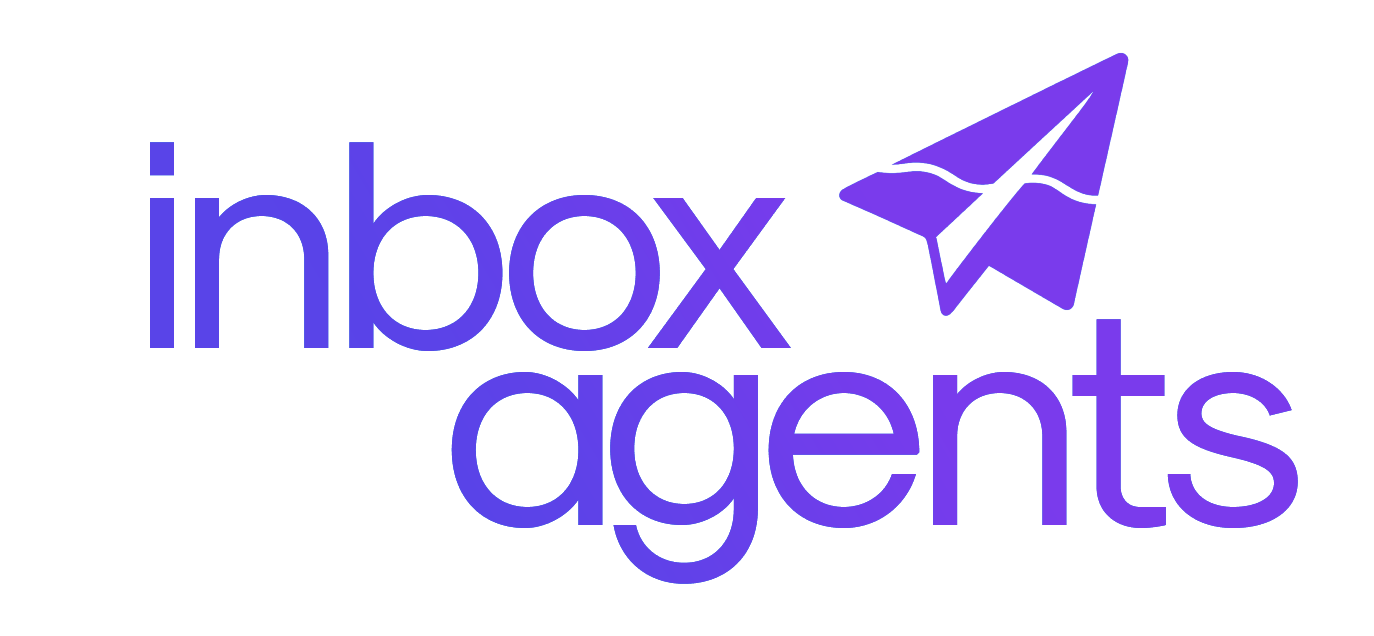
Top 7 AI Tools for Message Sentiment Analysis
Sentiment analysis tools make it easier to understand customer emotions across emails, social media, chats, and support tickets. These tools help businesses respond effectively to feedback, manage crises, and improve customer satisfaction. Here's a quick look at the top sentiment analysis platforms and what they offer:
- Inbox Agents: Combines messages from multiple platforms into one inbox, providing real-time analysis and automated summaries for better communication.
- BuildBetter: Uses advanced algorithms to analyze text and voice data, offering sentiment insights and prioritizing key messages.
- Talkwalker: Focuses on social media sentiment, with integrations for platforms like Slack and APIs for large-scale monitoring.
- Sprout Social: Tracks real-time sentiment on social media, highlighting urgent messages and supporting over 30 languages.
- Brandwatch: Provides detailed emotion detection and sentiment confidence scores, ideal for monitoring online reputation.
- Lexalytics (Semantria): Offers customizable APIs for developers to integrate sentiment analysis into their systems.
- Qualtrics Text iQ: Analyzes feedback from surveys and reviews, providing sentiment insights within the Qualtrics ecosystem.
These tools are designed to simplify communication workflows, detect trends, and prioritize issues based on emotional tone. Whether you're managing customer service, marketing campaigns, or product feedback, these platforms can provide actionable insights to improve your strategies.
Quick Comparison:
| Tool | Primary Focus | Best For | Key Feature | Language Support |
|---|---|---|---|---|
| Inbox Agents | Unified messaging analysis | Customer service teams | Real-time summaries | Multiple |
| BuildBetter | Text and voice sentiment | Product feedback analysis | Context-aware insights | Multiple |
| Talkwalker | Social media sentiment | Brand managers | Large-scale monitoring | 127+ languages |
| Sprout Social | Social engagement tracking | Marketing teams | Smart Inbox for priorities | 30+ languages |
| Brandwatch | Emotion detection | Enterprise reputation teams | Sentiment confidence scores | Multiple |
| Lexalytics | Custom API integrations | Developers | Industry-specific models | Multiple |
| Qualtrics Text iQ | Survey sentiment analysis | Customer experience teams | Integrated feedback insights | Multiple |
These tools help businesses turn unstructured data into measurable insights, making customer interactions more efficient and effective.
These 2 AI Tools know how you feel! AI Tools For Sentiment Analysis
How to Choose Sentiment Analysis Tools
Selecting the right sentiment analysis tool can help you address issues quickly and enhance your business communication strategies.
Real-time sentiment tracking is essential. Customer sentiment can change in an instant, especially during product launches, campaigns, or when negative trends arise. Tools like BuildBetter and Brandwatch Cortex offer real-time analysis, helping businesses respond promptly when it matters most.
Support for multiple languages is another key consideration. For instance, Talkwalker processes 127 languages with impressive accuracy, Lexalytics covers more than 20 languages with attention to linguistic nuances, and Qualtrics Text iQ handles several languages efficiently. These capabilities ensure your tool can handle diverse audiences without compromising accuracy.
Integration with existing systems is crucial for a seamless workflow. A good sentiment analysis tool should connect easily with CRM platforms, helpdesks, and communication tools. Many tools, for example, integrate with Zendesk, Salesforce, and Slack. Inbox Agents goes a step further by combining messaging with AI-powered smart replies and automated summaries.
Customization for specific industries can make a big difference in accuracy. Lexalytics (Semantria) offers custom sentiment models designed for industry-specific language and compliance needs. These tailored models can interpret unique terminology and even predict customer behavior by analyzing intent and emotions beyond basic sentiment scores.
Predictive analytics is another valuable feature. Tools like Talkwalker use predictive capabilities to identify potential churn, detect emerging trends, and prevent crises before they escalate. AI-powered features like alert detection and automated scoring also help flag anomalies and highlight key themes quickly.
Data privacy and compliance are non-negotiable, especially for businesses in regulated industries. Tools like Lexalytics and Brandwatch Cortex include features designed to handle sensitive data securely and transparently.
Lastly, evaluate scalability and pricing to ensure the tool aligns with your data needs, feature requirements, and budget.
The most effective sentiment analysis tools consolidate data across channels - social media, surveys, reviews, and support tickets - into unified dashboards. This centralized approach provides a complete view of customer sentiment, enabling better decision-making based on comprehensive insights.
1. Inbox Agents
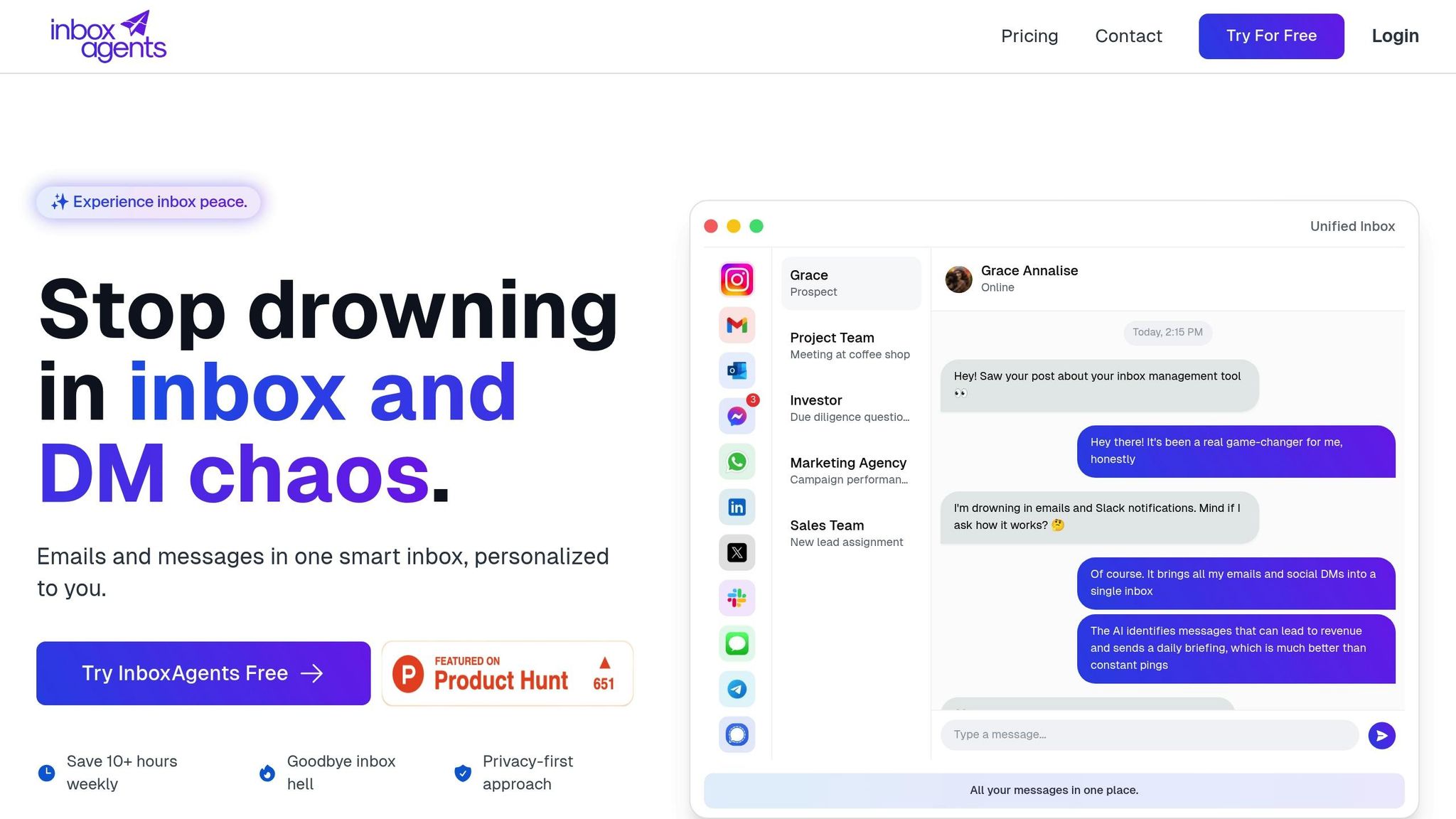
Inbox Agents is a messaging platform designed to streamline communication by integrating advanced AI tools directly into your daily messaging workflows. It brings together multiple messaging channels into a single, unified interface, making it a go-to solution for modern business communication. Here’s a closer look at what it offers.
Real-time Analysis
One of the standout features of Inbox Agents is its ability to analyze incoming messages in real time. This means you get immediate insights, allowing for quicker and more informed responses. With automated summaries, the platform provides a clear, concise daily overview, helping teams prioritize and manage messages more effectively.
Unified Messaging Across Platforms
Inbox Agents combines all your messaging platforms - email, social media, chat apps, and support tickets - into a single interface. This ensures you get consistent AI-powered analysis no matter where the communication originates. Its smart filtering and prioritization features automatically sort messages, flagging urgent ones for immediate action while routing others to the appropriate channels.
Practical Business Applications
This platform is particularly helpful for teams managing a high volume of communications. For sales teams, it can uncover key insights during proposal discussions, making it easier to address client needs. Customer service teams, on the other hand, can use real-time data from interactions to craft more personalized responses, ensuring concerns are addressed effectively and improving customer satisfaction.
For businesses handling large volumes of messages, the commercial insights feature is a game-changer. It provides an overview of communication trends, helping teams identify recurring issues, track improvements in customer satisfaction, and evaluate how communication strategies are impacting overall performance. By offering this level of insight, Inbox Agents empowers businesses to make data-driven decisions that enhance efficiency and effectiveness.
2. BuildBetter
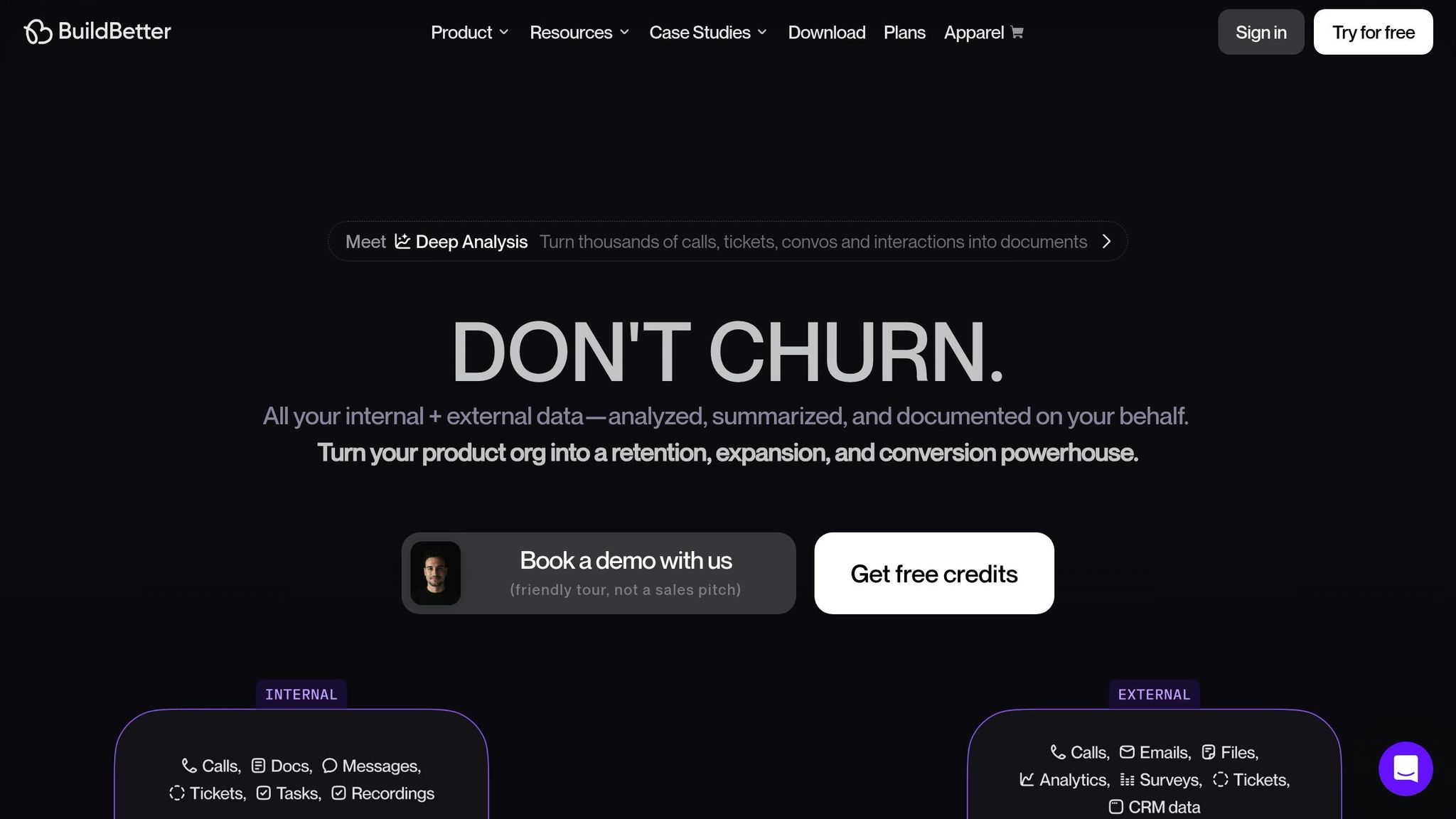
BuildBetter stands out by using NLP and machine learning to analyze text and voice data simultaneously, delivering real-time, integrated insights. Its three-step process for sentiment tracking ensures precise analysis, making it a powerful tool for businesses aiming to enhance communication efficiency and decision-making.
Real-time Sentiment Analysis
BuildBetter speeds up response times by up to 10x compared to older methods, thanks to parallel computation and optimized algorithms that process data instantly.
The sentiment analysis works through a structured three-step process. First, it gathers data from multiple sources like voice interactions, text messages, digital feedback, and internal communications. Then, it cleans and prepares the data by removing noise, normalizing text, and identifying languages. Finally, advanced algorithms analyze emotional cues, assign sentiment scores, and track emerging trends.
Integration with Messaging Platforms
The platform seamlessly integrates with multiple communication channels - support tickets, surveys, chats, and calls - organizing all feedback in a Real-Time Dashboard. This dashboard categorizes input by severity and frequency, making it easy to spot patterns. BuildBetter can handle up to 16,000 minutes of customer interactions each month, making it ideal for businesses with heavy communication demands. Whether customers connect via email, chat, phone, or social media, the platform helps track sentiment trends across all touchpoints.
Business Use Cases
The results are tangible. Teams save 18 hours per two-week sprint, eliminate 26 monthly meetings, and shift focus to revenue-generating tasks, increasing productivity by 43%. BuildBetter's real-time chat analysis answers critical business questions on the spot, using filters tailored to signal types, call context, customer profiles, and company-specific needs. With a 98% subscription retention rate, it’s clear users find value in the platform. For companies managing large volumes of customer interactions, BuildBetter’s ability to automatically prioritize and categorize messages based on emotional cues ensures teams focus on what’s most important.
3. Talkwalker
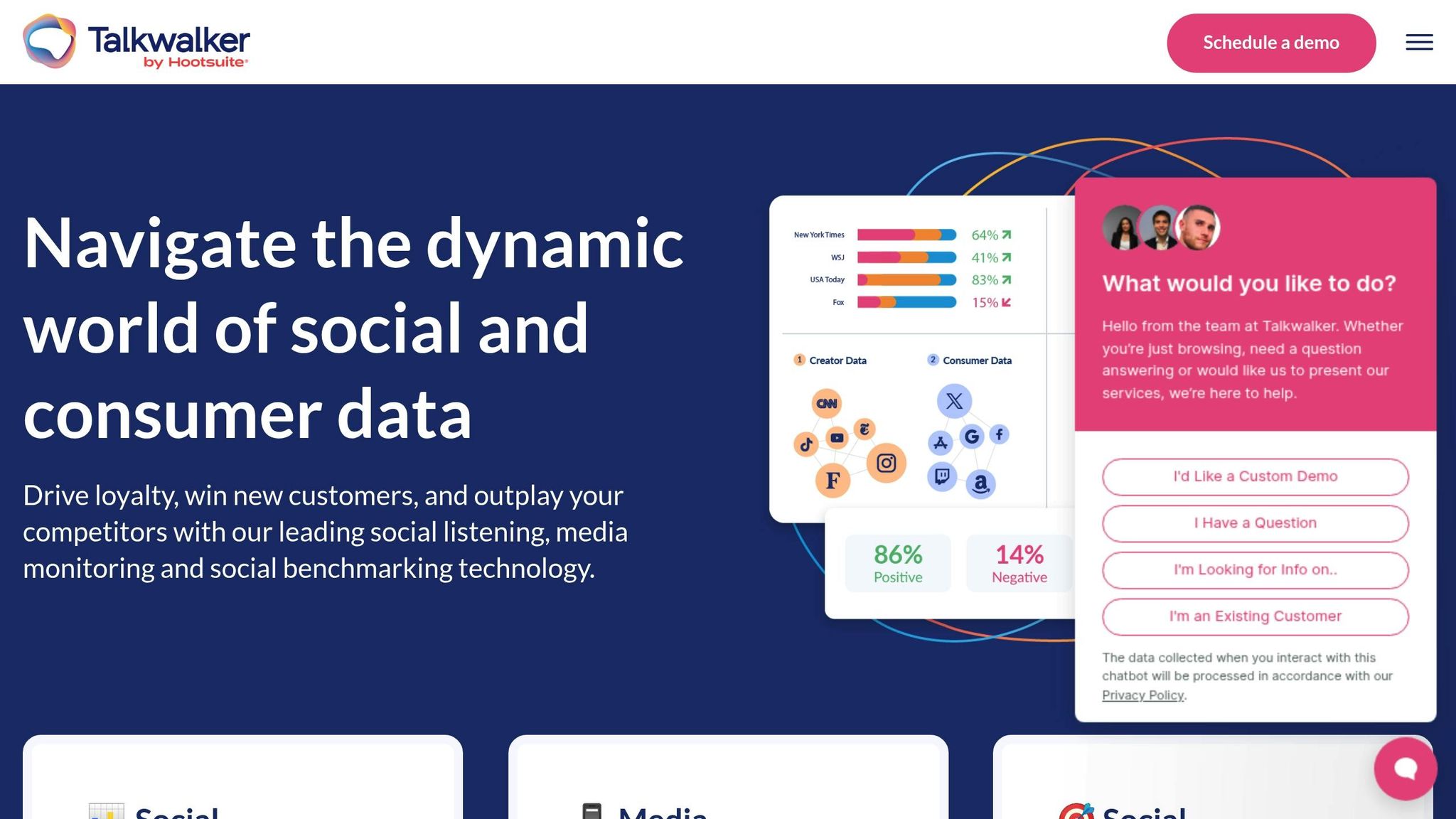
Talkwalker is a social listening tool designed to analyze sentiment and streamline communication workflows.
Integration with Messaging Platforms
Talkwalker works seamlessly with messaging platforms through automation tools. For instance, by using Zapier, you can connect Slack to Talkwalker. This setup allows automatic actions, such as dashboard updates, to be triggered whenever new messages are received. These integrations simplify the process of monitoring sentiment across various social media channels.
4. Sprout Social
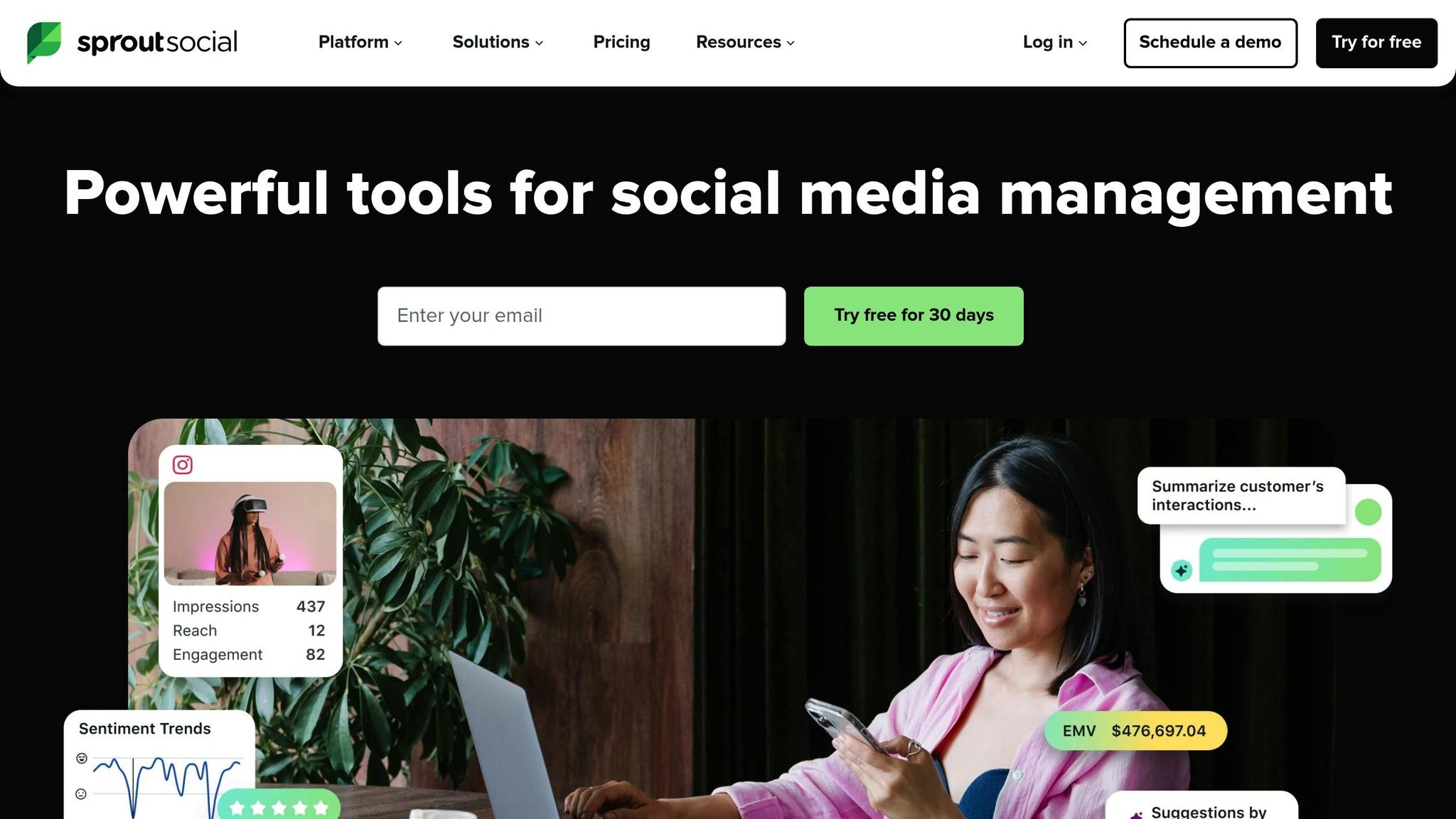
When it comes to social media, understanding customer emotions in real time is a game-changer. Sprout Social provides a powerful tool for sentiment analysis, helping businesses gauge emotions and opinions across multiple messaging platforms. This insight allows companies to better understand how their audience feels about their brand at any given moment.
Real-time Sentiment Analysis
Sprout Social’s sentiment engine works instantly, categorizing incoming messages as positive, negative, or neutral. It uses advanced language processing to pick up on nuances like sarcasm or shifts in tone based on context. This real-time capability ensures that urgent negative feedback gets flagged immediately for a quick response.
One standout feature is the Smart Inbox, which highlights high-priority messages based on sentiment scores. Negative messages are visually marked, making it easier for support teams to spot and address issues quickly. This ensures frustrated customers aren’t left waiting for help.
Integration with Messaging Platforms
Sprout Social integrates effortlessly with major platforms like Facebook, Twitter, Instagram, LinkedIn, and YouTube. It pulls messages from all connected accounts into one unified dashboard, applying sentiment analysis to every interaction.
The platform also includes a collision detection feature that prevents duplicate responses while maintaining the sentiment context. This ensures replies are consistent in tone - enthusiastic for positive messages and empathetic when addressing concerns.
Multi-language Support
For global brands, Sprout Social’s ability to handle sentiment analysis in over 30 languages is a major advantage. Supported languages include Spanish, French, German, Portuguese, and Japanese, among others.
The platform automatically detects the language of an incoming message and applies the appropriate sentiment model. While it works best with English content due to its training data, its performance across other languages remains reliable, enabling businesses to manage customer interactions tailored to different markets.
Business Use Cases
Sprout Social’s features aren’t just technical - they translate into practical benefits for businesses.
- Customer service teams use it to prioritize support tickets based on emotional urgency. Negative messages are routed for immediate attention, while positive feedback can be flagged for testimonials or case studies.
- Marketing teams rely on sentiment data to evaluate campaign success and track changes in brand perception. Reports highlight sentiment trends over time, helping marketers identify which content resonates positively and which topics may need rethinking.
- Crisis management becomes more proactive with Sprout Social. The platform detects sudden spikes in negative sentiment, alerting communication teams to address potential issues before they escalate. This is especially helpful during product launches or when navigating public relations challenges.
sbb-itb-fd3217b
5. Brandwatch
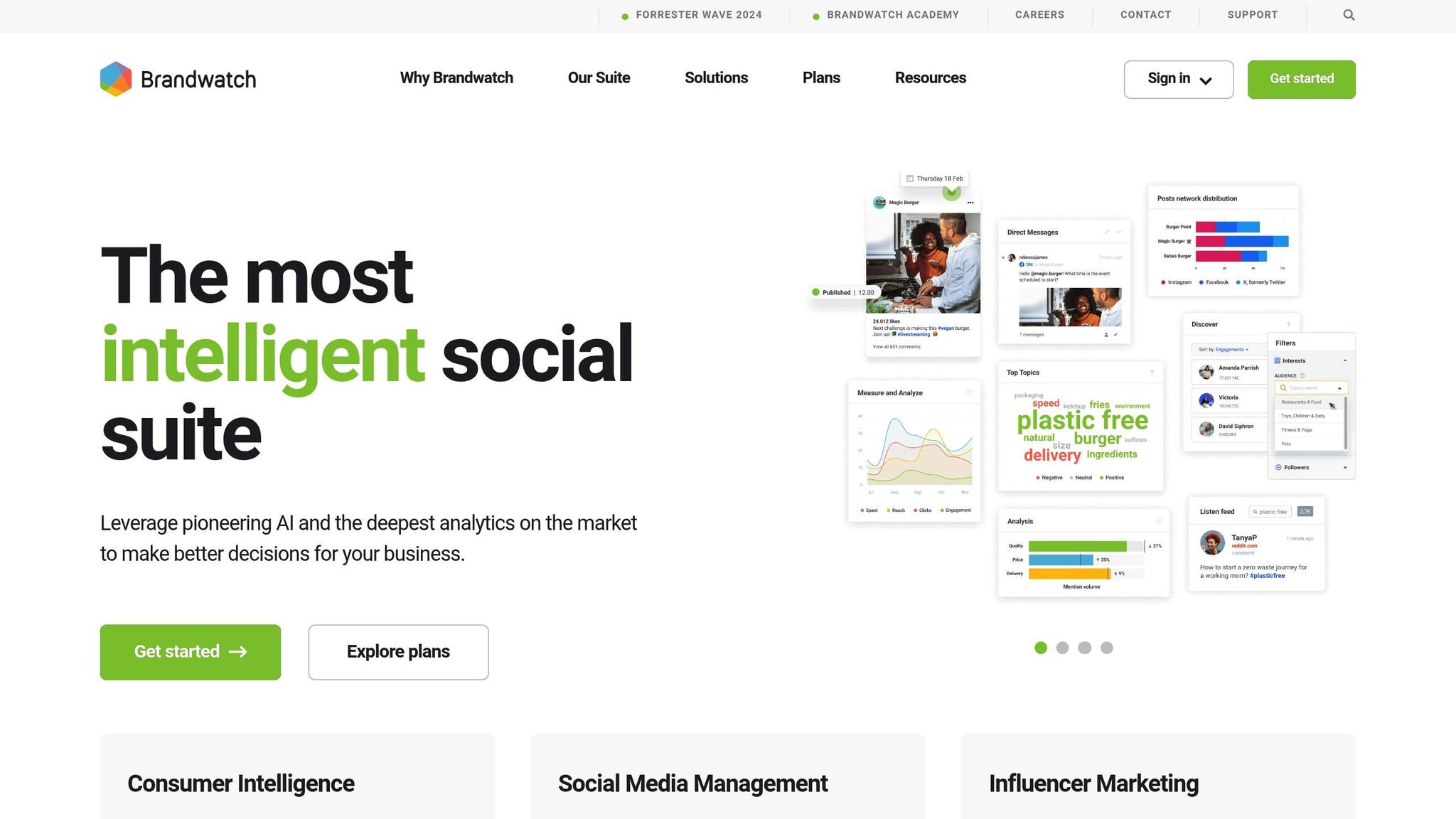
Brandwatch is a powerful tool for social listening, designed to analyze sentiment across a wide range of online conversations. It helps businesses understand and respond to customer emotions effectively, ensuring clear and meaningful communication. Its foundation lies in offering advanced insights through detailed analysis.
Real-time Sentiment Analysis
Brandwatch's sentiment engine uses machine learning to classify messages as positive, negative, or neutral. It also identifies emotions like joy, anger, fear, and surprise. The system is smart enough to adapt to context and industry-specific language. For instance, a word that signals enthusiasm in one context might imply criticism in another. This adaptability helps brands avoid misinterpreting customer feedback.
To ensure accuracy, Brandwatch provides sentiment confidence scores. These scores highlight messages where the analysis is most reliable, while those with lower confidence can be flagged for manual review. This approach ensures that critical feedback is reviewed thoroughly.
Integration with Messaging Platforms
Brandwatch monitors sentiment across various platforms, including social networks, forums, blogs, news sites, and review platforms. For private conversations, it integrates seamlessly with messaging services like Facebook Messenger, Instagram Direct, and Twitter DMs through API connections. This integration allows the platform to automatically apply sentiment analysis to direct messages, helping customer service teams prioritize responses based on the emotional tone of incoming messages.
The platform also offers Boolean search capabilities, enabling users to create precise queries that filter out irrelevant noise. This ensures sentiment analysis focuses on the feedback that truly matters. Combined with its robust integration features, Brandwatch delivers comprehensive data collection and analysis.
Multi-language Support
Brandwatch supports a wide range of languages, including English, Spanish, French, German, Italian, Portuguese, Russian, Chinese, Japanese, and Arabic. It preserves cultural nuances by automatically detecting the language of incoming messages and applying the appropriate model. This feature is especially valuable in markets with diverse linguistic needs.
Business Use Cases
Brandwatch serves various business needs. Reputation teams rely on it to monitor sentiment changes during product launches or crises. Product teams use its tools to identify key feedback trends, while marketers leverage its analytics for competitive benchmarking and evaluating influencer campaigns. Its versatility makes it an essential tool for understanding and acting on customer sentiment.
6. Lexalytics (Semantria)
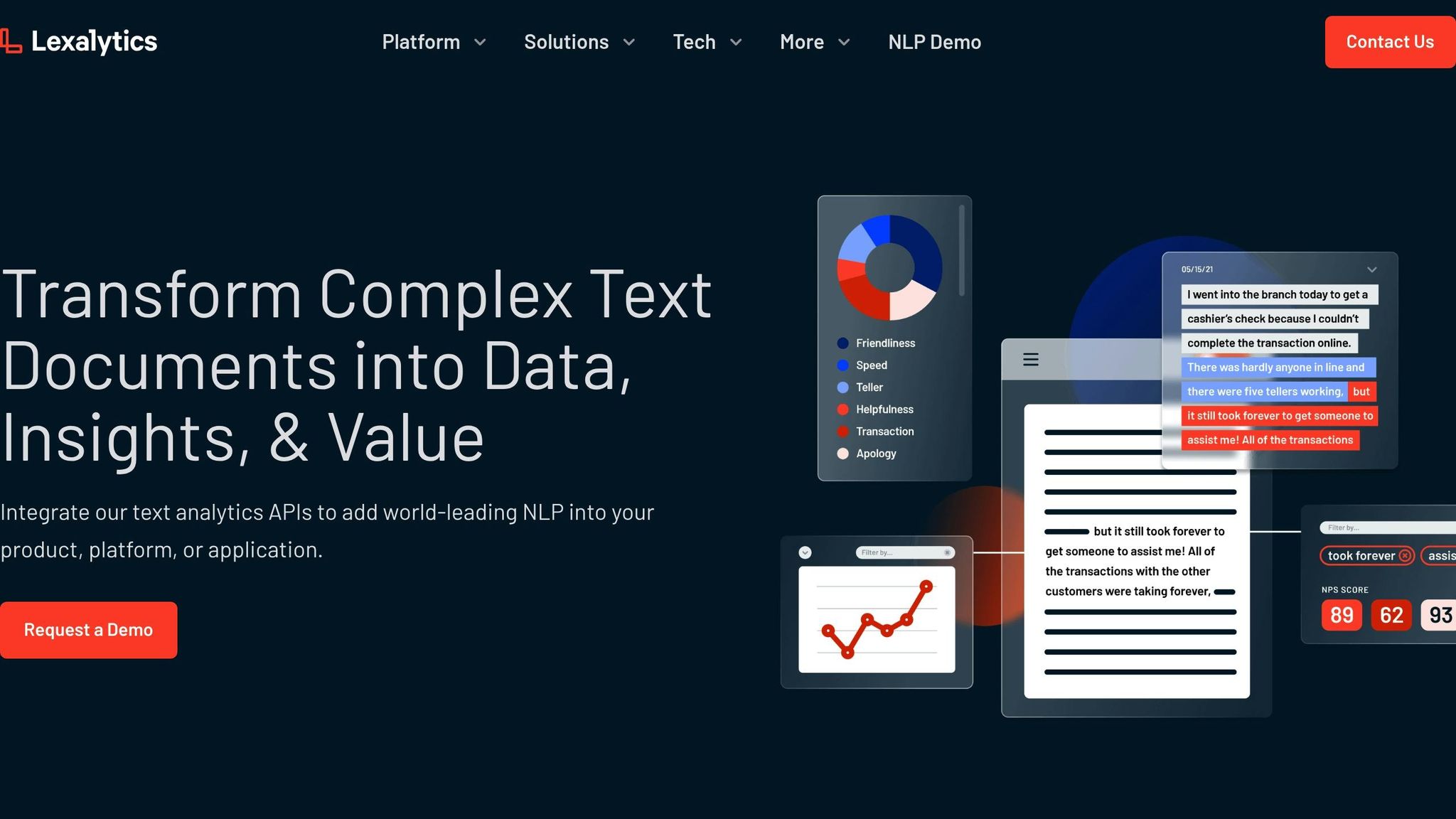
Lexalytics’ Semantria platform specializes in sentiment analysis, offering a RESTful API and SDK support in multiple programming languages. This setup makes it easy to integrate sentiment insights directly into email, chat, and support channels. Unlike tools that focus mainly on prebuilt messaging integrations, Semantria takes an API-first approach, allowing businesses to extract meaningful data and gain deeper insights from their messaging platforms.
7. Qualtrics (Text iQ)
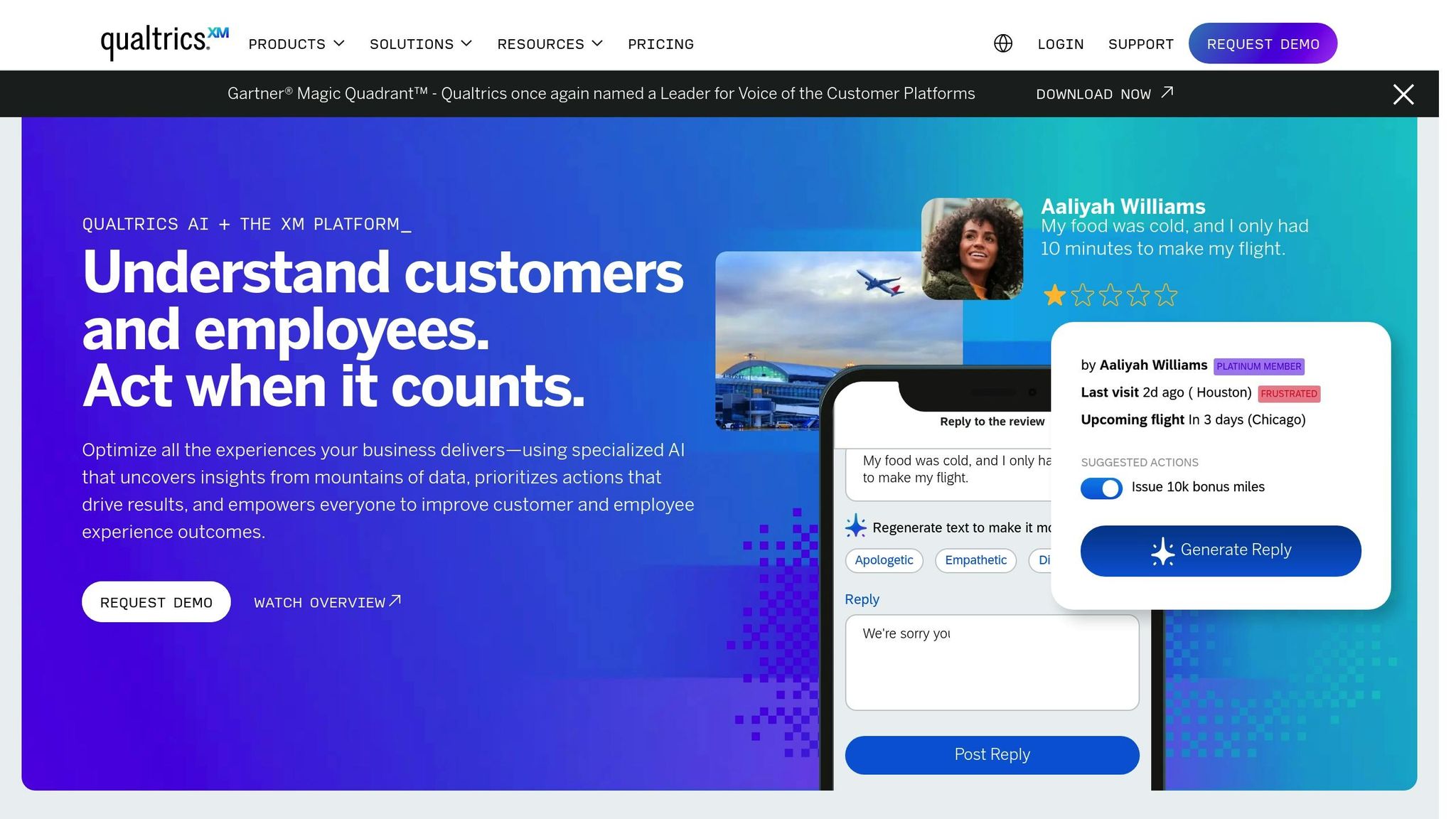
Qualtrics Text iQ turns survey and review data into meaningful insights about customer sentiment. By leveraging natural language processing (NLP) and machine learning, it dives into unstructured text to uncover how customers truly feel.
Sentiment Analysis Capabilities
Text iQ categorizes feedback into positive, negative, or neutral sentiments, offering a deeper understanding of customer emotions. This analysis integrates smoothly with Qualtrics' other analytics tools, making it easier to identify patterns and trends in feedback.
Built-In Integration with Qualtrics
As part of the Qualtrics platform, Text iQ automatically transforms survey and review responses into detailed sentiment profiles and trend reports. This integration ensures that businesses can act on insights without added complexity.
Support for Multiple Languages
Text iQ can analyze feedback in various languages, taking into account linguistic differences to provide accurate sentiment assessments across diverse customer bases.
Practical Applications for Businesses
Companies rely on Qualtrics Text iQ to make sense of qualitative feedback. By tracking sentiment patterns, businesses can refine their strategies to better meet customer expectations and improve overall satisfaction levels.
Feature Comparison
The accuracy of sentiment analysis has made impressive strides, jumping from 60% in 2015 to over 90% by 2025. Most platforms now achieve 85–90% accuracy, even capturing subtleties like sarcasm and contextual nuances. Research also indicates that 75% of businesses prioritize tools with seamless integration. The table below breaks down the key strengths, ideal use cases, integration capabilities, and accuracy focus of various sentiment analysis tools.
| Tool | Primary Strength | Best Use Case | Integration Level | Accuracy Focus |
|---|---|---|---|---|
| Inbox Agents | Unified messaging with AI-driven filtering | Customer service teams managing multiple platforms | High – unified inbox approach | Real-time message analysis with personalized responses |
| BuildBetter | Product feedback analysis | Product teams analyzing user interviews and feedback | Medium – product-focused integrations | Context-aware sentiment in product discussions |
| Talkwalker | Large-scale social media monitoring | Brand managers tracking online reputation | High – social platform APIs | Multi-language social sentiment detection |
| Sprout Social | Optimizing social engagement | Marketing teams managing social presence | High – native social integrations | Engagement-focused sentiment scoring |
| Brandwatch | In-depth social listening insights | Enterprise brand intelligence teams | High – comprehensive data sources | Advanced emotion detection beyond basic sentiment |
| Lexalytics | Customizable text analytics engine | Developers building custom sentiment solutions | Very High – API-first architecture | Industry-specific sentiment models |
| Qualtrics Text iQ | Survey and feedback analysis | Customer experience teams analyzing structured feedback | High – Qualtrics ecosystem integration | Multi-language survey sentiment analysis |
These tools demonstrate a wide range of capabilities, from unified messaging and real-time insights to customizable, API-driven analytics. Interestingly, human sentiment agreement typically falls between 80–85%, underscoring how advanced these tools have become. Many now include features like emotion detection and multilingual support to interpret more nuanced feedback.
The global AI sentiment analysis market is on a rapid growth trajectory, expected to expand from $2.6 billion in 2022 to $10.6 billion by 2025. This growth reflects how businesses are increasingly embracing these advanced tools to gain deeper insights from customer interactions.
Conclusion
AI-powered sentiment analysis tools have reshaped the way businesses interpret and react to customer emotions. With accuracy levels now hovering around 90%, these systems have progressed far beyond simple text analysis, evolving into tools capable of understanding nuanced emotional contexts.
By turning raw feedback into actionable insights, sentiment analysis enables brands to respond more thoughtfully and efficiently. This ensures that customer input directly informs smarter, more customer-centric decisions.
Taking things further, integrated platforms now combine sentiment analysis with streamlined communication. Tools like Inbox Agents bring all messaging channels into one interface, using AI to identify urgent messages, filter out noise, and craft personalized responses. This approach not only simplifies communication management but also ensures businesses stay attuned to critical emotional shifts in real time.
As this technology continues to improve, companies that leverage AI-driven sentiment analysis will be better equipped to understand their customers’ emotions and respond with the speed and empathy that today’s consumers demand.
FAQs
How can AI-powered sentiment analysis tools enhance customer satisfaction for businesses?
AI-driven sentiment analysis tools are transforming how businesses connect with their customers by enabling real-time understanding of emotions. These tools analyze the tone and sentiment behind messages, paving the way for more tailored and compassionate communication. The result? Stronger bonds with customers and a deeper sense of trust.
Beyond just understanding emotions, these tools help businesses stay ahead of potential problems. By identifying issues early, companies can provide timely support, which not only resolves concerns but also strengthens customer loyalty. On top of that, by digging into customer feedback, online reviews, and social media chatter, businesses can uncover trends and pinpoint areas that need attention. This leads to better service and fuels overall growth.
What should businesses look for in a sentiment analysis tool?
When choosing a sentiment analysis tool, it's essential to focus on key features like precise sentiment detection, the capability to monitor sentiment trends over time, and in-depth insights categorized by topics or user groups. Make sure the tool can seamlessly integrate with your current systems and manage high data volumes without issues.
You should also evaluate how user-friendly the tool is, whether it offers customization options, and if it fits your unique business goals - whether that's analyzing customer feedback or refining your communication strategies.
How can integrating sentiment analysis tools improve business communication strategies?
Integrating sentiment analysis tools into your systems can transform how your business communicates. These tools offer real-time insights into customer emotions and the tone of messages, enabling your team to respond with greater empathy and personalization. The result? Happier customers and stronger connections.
Another key benefit is the ability to quickly spot and address negative sentiments. This proactive approach helps reduce customer churn and strengthens relationships over time. With sentiment analysis, businesses can create more meaningful interactions, nurture loyalty, and ultimately boost revenue.
